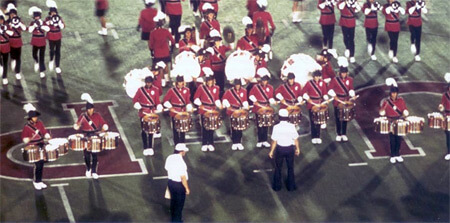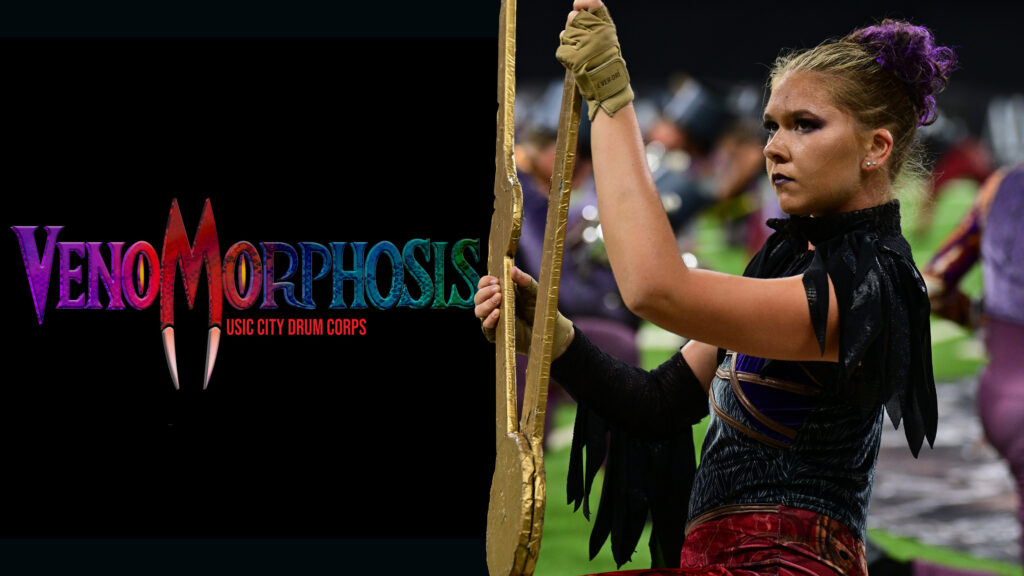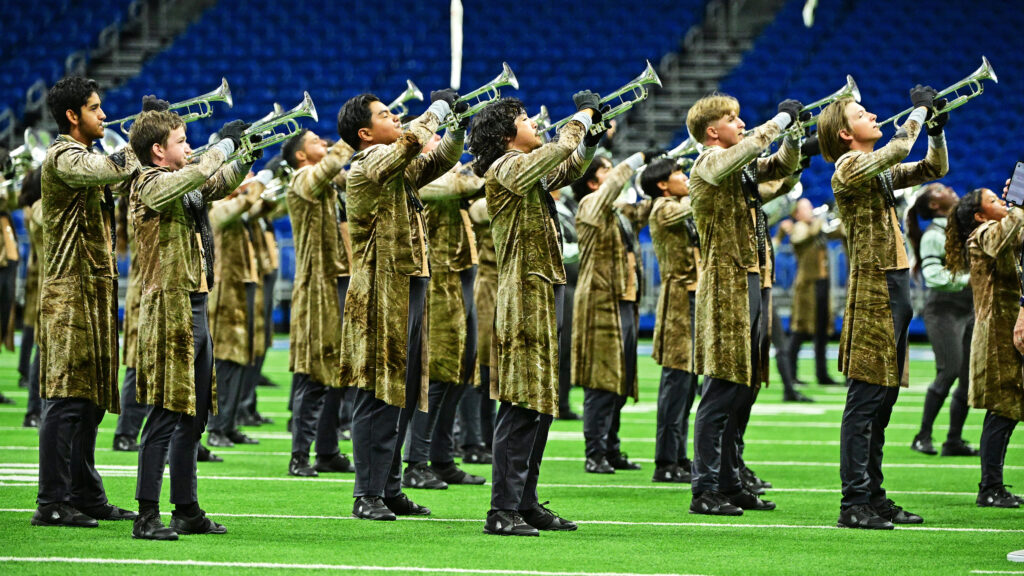Thomas Brown sent me a note reminding me of Drum Corps International’s first drum line dynasty, the Santa Clara Vanguard drum line from 1973 through 1975. This line had a winning streak of 54 shows, (a streak ended by the Blue Devils, a line that included today’s Blue Devils arranger and instructor Scott Johnson), went undefeated in 1973 and 1974 and won high percussion honors at the 1973, 1974 and 1975 DCI World Championships.
Taught by DCI Hall of Fame member Fred Sanford, the line popularized a more symphonic approach to drumming than what was typical for the day.
Thomas adds that an up and coming arranger was a ghost writer who contributed to the 1975 show; none other than DCI Hall of Fame member Ralph Hardimon.
It was requested that this column be published in memory of Fred Sanford and Mike LaPorta. -Michael Boo
Dale Lofgren marched as a tenor drummer and then snare drummer with the Kingsmen in 1973 and 1974 and moved to Santa Clara Vanguard in 1975 when the Kingsmen did not field a corps. He is the section leader for the Kingsmen Alumni Corps that will be performing at the DCI World Championship Semifinals this coming week.
The first time that I saw the Santa Clara Vanguard (SCV) drum line was in San Diego in 1972. It was my first year in a drum corps as a snare drummer in the California Carson Crusaders. I had cut my corps teeth on the teeming southern California corps landscape. Then, in Balboa Park under a light in the darkness, I saw five snare drummers warming up in crimson red uniforms with curled bright white ostrich plume feathers swaying gently from the top of their hats as they played powerful syncopated flam rhythms and mathematically correct big-spaced tap rolls. They seemed very confident and otherworldly. That year, the Santa Clara Vanguard went on to have a very successful season until the inaugural DCI World Championship in Whitewater, at which time the corps and drum line lost to the Anaheim Kingsmen.
For the SCV drum line, the 1972 championship was an experience they would never forget and it helped propel them to their three successive DCI drum titles and two undefeated seasons. Under the direction of Fred Sanford, arranger extraordinaire and the snare genius of Robert “Bob” Kalkoffen, the early-to-mid 1970s SCV drum lines were a magical mixture of percussive science and art.

The elements of drumming science included playing with sticks that had the back ends cut off an inch with the tip ends weighted down with spirals of white tape. This design allowed the snares to play low with power. As Kalkoffen would say, “The lower you play, the less room for variance and the fewer the tics (mistakes).” The shorter sticks also allowed the snares to stand closer to each other, thereby increasing listening and hearing capability as well as creating a tighter wall of snare sound.
The snare line marched with a slightly stiff left leg, thereby greatly reducing the motion and movement of the snare drum that resulted in a more stable and consistent playing surface. [Note: This was when snares rested on the left leg, worn hanging from a sling rather than the harnesses of today.] Many, if not most, of the snares had a downward left shoulder lean that allowed them to turn the left bead back with more power. The theory was that one needed to give the left hand 15 percent more effort in order for it to match the power and volume of the right.
The line played with 90 percent wrist and 10 percent arm. To develop the powerful sound, players learned to play through the top drum head and literally tried to reach the bottom head with the beads on their sticks. The snare line was cleaned by matching each snare individually to the center “anchor” snare. Every snare listened in one player toward the center and matched every aspect of their partners’ playing.
SCV snare playing was also an art. There was a very strong emphasis on developing as a musician and on how one sounded individually as a player. Underlying everything was great music that was played intelligently with heart, soul, dignity, class and confidence. The line played beautiful, expressive and powerful parts.
The highlight year of this drumming era was arguably the 1975 drum line. In the snare line was Paul “the-snare-scientist-epitome-of-anchor-snares” Siebert, Rob “the-inhumanely-android-fast: Carson, Rob’s 15-year-old prot?©g?© Darryl Cox, the soulful musician Curt Moore, who had marched as an SCV snare since 1971, the intelligent Allan Kristensen (a current DCI judge), the incredible soloist Steve Chorazy, who won an individual award that year, the graceful and strong Thomas Brown from New Jersey (who also marched with the Blessed Sacrament Golden Knights and Polish Falcons), who was in his second year with SCV, and myself, who had marched as a snare with the Kingsmen the year before. 1975 marked the end of SCV’s formative core group membership, a group that had grown up and developed this fine corps together in a yet (at the time) innocent small town valley still checkered with cherry tree groves.
Curt Moore, who co-wrote the famous 1975 “Birds of Fire” drum solo and later taught the corps, remembers the best show from that era.
I can’t imagine that those of us who played in the 1975 line would say there was a better show than the World Open. Yeah, we got a “one-tick sheet” at the DCI Championship, but (instructor) Kalkofen always told us that our best shows would the ones we don’t remember. Marching the World Open show was like being in a dream, it didn’t seem real. But, I do remember not hearing a single mistake! After the show we were all standing there like deer in the headlights, not saying anything, just staring at each other thinking the same thing, “Did you hear that?”

Allan Kristensen seconds the above memory. Without a doubt, I agree with Curt. The 1975 World Open was an out of body experience! It was an experience that I don’t think many other people can understand. Even other musicians and drum corps members don’t have an opportunity to have an experience like that very often, if at all. We were a unified machine: Focus, concentration, experience and talent like that don’t come together like that often. It was there for a full year and at that performance that we took it to another level. After all these years, many members of this group remain close to this day.
When I was first contacted regarding this story, it was requested that I run a list of the members of the drum line in that era. While I have never done so in the past, I carefully read the list and realized how many of the names I had heard from other endeavors after their marching days … judges, directors, instructors, etc. Some of you with a little history behind you will also pick up on a surprising number of names from this list.
Oscar Acosta, Tom Andrews, Chuck Boblenz, Mike Braga, Dwayne Brown, Thomas Brown, Tad Carpenter, Rob Carson, Steve Chorazy , Daryl Cox, Greg Douglas, Tom Eschenfelder ,Kurt Gallblats , Rob Garrett, Jim Hurt, JW Koester, Allan Kristensen, Mike LaPorta, Dale Lofgren, Keith Melot, Robin Menke, Al Montemayor, Mike Montes, Curt Moore, Kurt Petersen, Rick Riplinger, Peter Romo, Tony Romo, Louie Ruocco, Wally Schnalle, Gary Seibert, Paul Seibert, Phil Silviera, Jeff Spencer, Tim Stolzman, Mark Waxman, Greg Whalen, Jeff White.
Editorial assistance by Michael Boo. Fanfare archives





